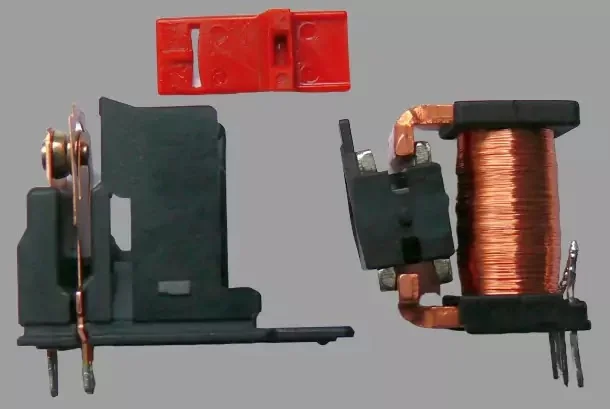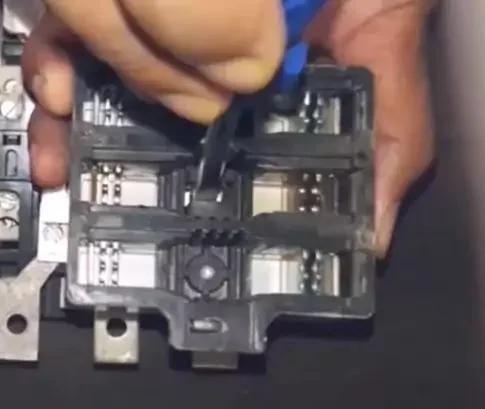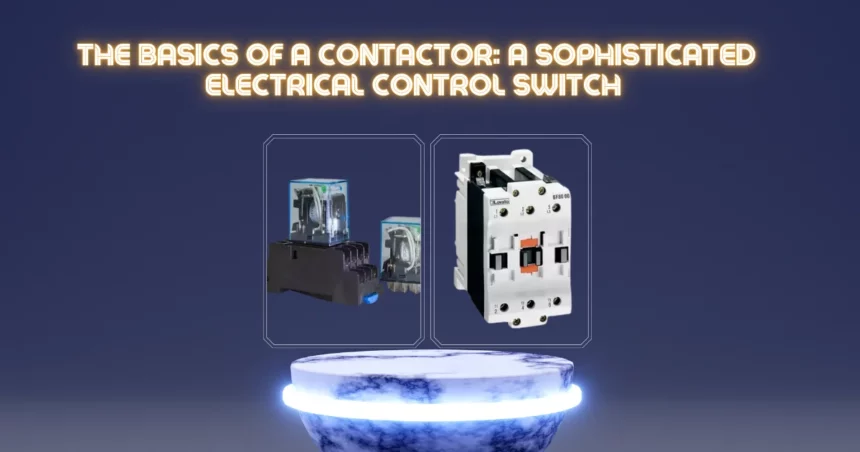Are you curious about what a contactor is? Well, a contactor is not just your ordinary switch. It’s a sophisticated electrical control switch used to connect or disconnect circuits. One of the coolest things about a contactor is its ability to control multiple circuits with just one switch. Yes, you read that right! With a contactor, you can control multiple things at the same time.
Multipole Magic
Unlike a regular switch that only controls one circuit, a contactor is designed with multiple capabilities, which means it can control several circuits with just one switch. This feature alone makes it a standout device in electrical control switches.
Electromagnetic Control
One of the fascinating things about a contactor is how it’s controlled. It’s more complex than just pushing a button to turn it on and off. Instead, a contactor is controlled by electromagnetism, which means that one signal is all it takes to turn it on and off. This dynamic characteristic makes it a unique and efficient type of switch.
Applications of a Contactor
The contactor is widely used in various industries, such as manufacturing, transportation, and construction. They are used in machines, motors, lighting systems, heating and cooling systems, and other electrical equipment. They are also used to control high-voltage circuits, making them essential in power generation and distribution systems.

How do Contractors Work?
Have you ever wondered how contractors work? Well, they are not your typical mechanical switches found in homes. Contractors are advanced electrical control switches that use electricity to turn circuits on and off. Let’s dive deeper into how they work.

The Coil
Inside a contractor, you’ll find a coil wrapped around two iron cores, one at the bottom and the other at the top. When an electric current passes through the coil, it creates a magnetic field that attracts the two iron cores together, closing the switch.
Control Supply
To control a contractor, you need a controlled supply. The coil voltage is critical in determining the type of control supply required. A 230v coil is used for single-phase controlling, while a 415v coil is used for three-phase controlling. However, in many cases, a single-phase supply is sufficient, so a 230v coil is typically used. It’s worth noting that the coil can operate on voltages ranging from 220v to 250v.
Power Supply
To power a contractor, a separate power supply is required. The contractor’s control supply turns the switch on and off.
Working Principle of Contactors

In a contractor, L1, L2, L3, and No terminals are used for incoming circuits, while T1, T2, T3, and No are used for outgoing circuits. The contractor is open until the coil is supplied with electricity. When the supply is given to the coil, the magnetic field attracts the two iron cores together, closing the switch and turning on the circuit. When the electricity is removed from the coil, the switch returns to its original position, and the circuit turns off.
Poles
Contractors are available with varying numbers of contacts, known as poles. They come in 2, 3, or 4 poles, indicating the number of circuits they can control. A four-pole contractor, for instance, can control four circuits in and four circuits out.
Applications
Contractors are widely used in various industries, including manufacturing, construction, transportation, and power generation. They’re used in motors, lighting, heating, cooling, and other electrical equipment. They’re also used to control high-voltage circuits, making them an essential component in power generation and distribution systems.
What are Relay and Contactor, and how do they work?
Relay and contactor are two devices that are widely used in electrical applications. Both work on the same principle – they use a coil that, when energized, allows the contacts to be closed. However, there are differences between them that make them suitable for specific applications.
RELAYS:

Relays are typically used in applications where the load current rating is not more than 20 Amps. They are mostly seen in low voltage situations such as safety and automation purposes like automatic light control. They usually use a single-phase supply.
Relays are smaller than contactors and are sold based on normally open and normally closed contacts used in different circuits. Relays are the best option for operating small and low-voltage circuits.
CONTACTORS:

Conversely, contactors are designed to carry much higher loads, such as motors, fans, etc. Most contractors are used for 3 Phase System Applications. This requires three separate conductors to run through our contactor. However, we can only use one or two contacts in our contactors for single-phase applications.

Contactors come with Auxiliary Contacts, which allows us to monitor the state of the actual contractor itself, whether it is open or closed. In a high voltage situation, they can also offer ARC suppression, which can increase the safety level of our contactors. While contactors do not offer any short circuit or high voltage or low voltage protection, new devices are found and sold separately for these purposes.
key differences between Relay and Contactor
Relay:
- Used in applications where the load current rating is not more than 20 Amps
- Typically used in low voltage situations, such as for safety and automation purposes
- Sold based on normally open and normally closed contacts
- Smaller in size compared to contactors
- Faster switching time for low voltages, making it suitable for small applications like automatic light control
Contactor:
- Designed to carry much higher loads, such as motors and fans
- Typically used for 3 phase system applications, requiring three separate conductors
- Comes with auxiliary contacts for monitoring the state of the contractor
- Offers arc suppression in high voltage situations, increasing safety
- It does not offer short circuits or high/low voltage protection, requiring separate devices.
Parts of Contactor:
Contactors are vital components in electrical circuits, but have you ever wondered what parts make up this small yet essential device? Let’s dive into the various parts that make up a contactor.
Protective Upper Cover

The upper cover of a contactor is made of sturdy, hard plastic material that shields the internal parts from external elements like dust, moisture, and even water. However, not all contactors are water-resistant, and those that are, come at a high cost.
Contacts: The Key Players

The contacts are the heart of the contactor. They are typically the first component to wear out due to the high-frequency operation of the device. The number of poles in a contactor determines the number of contacts. For instance, a five-pole contactor will have five contacts. There is a space between each contact to ensure easy movement. Take a look at the image below, which shows three-pole contacts.
Magnetic Layers: The Support System

A contactor’s magnetic layer is an essential part that works in conjunction with the contacts. These layers are located at the top and bottom of the contactor and are separated by a spring. The magnetic layers allow the magnetic field to pass from one layer to another, thanks to the spring’s assistance.
The Spring: Vital for Magnetic Field Transfer


The spring plays a crucial role in the contactor’s operation. It helps transfer the magnetic field from one magnetic layer to the other when the field is established. Without the spring, the magnetic field would be unable to move from one layer to the other, and the contactor would fail to operate.
Coil: The Magnetic Field Produce
Lastly, the coil produces the magnetic field the contactor requires to operate. It is typically a thin wire wrapped around a plastic core, as seen in the image above.

Types of Contactors: Understanding the Three Main Types
Regarding contactors, there are many different types to choose from. But among the plethora of options, three types stand out: the magnetic contactor, the knife blade switch, and the manual controller. Each has its unique features, advantages, and disadvantages. Let’s dive in and learn more about these three main types of contactors.
Magnetic Contactor: The Efficient Choice

Magnetic contactors are the most commonly used type of contactors. They are efficient because they work on the magnetic field, so they don’t require human interaction. If you want to connect any relay and send signals to the relay, you can use this type of contactor. Magnetic contactors use a very small amount of current to energize, which means they need a small amount of current to open and close the circuit. Additionally, these contactors have auxiliary contacts that may vary in size and can be DC or AC.
Knife Blade Switch: The Original Contactor
The knife blade switch was the first type of contactor introduced in 1800. They were very popular and were used in industries to control high-voltage motors. The name of this type of contactor was given because it consists of a jaw or a knife used to control the electricity. However, as technology advanced, newer motors were introduced, and the bigger the motors, the higher currents required to work. The knife blade switch was no longer effective or safe to use due to the short life of such switches.
Manual Controller Contactor: The Safe and Reliable Solution
After the knife switch, experts and analysts thought of another contactor gadget that offered high-quality material and was long-lasting. The new structure was known as the manual controller. It has two-fold break contacts designed to open the circuit in two places simultaneously. This ensures that even in smaller spaces, the current can be worked on progressively. As the name suggests, the two-fold break contacts break associations with the end goal that its structure two shows arrangements of contacts. The catch or switch of the manual controller is attached to the controller so that it cannot work remotely.
The force circuit is locked in when the manual controller is developed, carrying the electric currents to the load. Due to its better performance and safety features, manual contactors replaced the blade cutting edge switches. They are still used today, but less than in the 1900s.
Types of Contactors and Their Applications
Contactors are versatile switching devices widely used in industrial and residential applications. They are designed to handle high voltage and current levels, making them an essential component in various electrical systems.
Motor Starter:
In motor starter circuits, contactors are used for switching the motor on or off, along with overload and short circuit protection. These contactors can be either Direct-on-Line or Star Delta, depending on the specific requirements of the motor.
Capacitor Switching Contactor:
Capacitor banks use capacitor-switching contactors to switch capacitors, depending on the system’s specific requirements. These contactors are designed to control high transient currents during switching.
Lighting Control:
Contactors are used in the lighting systems of streets, commercial buildings, and residential areas. They are particularly useful in timer-controlled lighting systems.
Choosing the Right Contactors
The contactors’ selection depends on the load’s size, voltage, and current levels. Proper selection of contactors is crucial to ensure the efficient and safe operation of electrical systems.
Checking of Contactors
It is important to check contactors regularly to ensure their proper functioning. This can be done with the help of an ohmmeter. If the ohmmeter shows a value, the contacts are open. If the value is zero, it indicates that the contacts are closed.
Conclusion
To conclude, a contactor is an advanced electrical control switch that uses electromagnetism to connect or disconnect circuits, making it a unique and efficient type of switch. It can control multiple circuits with just one switch, making it stand out among other electrical control switches. The contactor is widely used in various industries, including manufacturing, transportation, and construction.
It controls high-voltage circuits, making it essential for power generation and distribution systems. In contrast, relays are typically used in low voltage situations where the load current rating is not more than 20 Amps, while contactors are designed to carry much higher loads such as motors and fans. Therefore, it is important to understand the differences and choose the most suitable device for specific applications.
MORE STORIES:










I’d like to thank you for the efforts you have put in penning
this site. I am hoping to view the same high-grade blog posts from you in the future as well.
In truth, your creative writing abilities has inspired me to get my own website now 😉